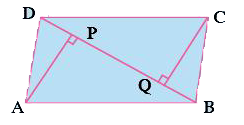ABCD is a parallelogram and AP and CQ are perpendiculars from vertex A and C on diagonal BD.
Show that (i) ΔAPB≅ΔCQD (ii) AP=CQ. Solution in Tamil
The correct Answer is:(i) ΔAPB≅ΔCQD , (ii) ;. AP = CQ
Step by step video, text & image solution for ABCD is a parallelogram and AP and CQ are perpendiculars from vertex A and C on diagonal BD. Show that (i) DeltaAPB~=DeltaCQD (ii) AP=CQ. by Maths experts to help you in doubts & scoring excellent marks in Class 9 exams.
Updated on:21/07/2023Topper's Solved these Questions
- GEOMETRYBOOK - FULL MARKSCHAPTER - GEOMETRYEXERCISE - Assignment (I. Choose the correct answer)
5 Videos
- GEOMETRYBOOK - FULL MARKSCHAPTER - GEOMETRYEXERCISE - Assignment (II Match the following)
1 Videos
- GEOMETRYBOOK - FULL MARKSCHAPTER - GEOMETRYEXERCISE - Additional Questions I. Multiple Choice Question.
20 Videos
- COORDINATE GEOMETRYBOOK - FULL MARKSCHAPTER - COORDINATE GEOMETRYEXERCISE - TEXTBOOK ACTIVITY
2 Videos
- MENSURATION BOOK - FULL MARKSCHAPTER - MENSURATION EXERCISE - Assignment (II. Answer the following questions)
8 Videos
Similar Questions
ABCD is a cyclic quadrilateral. Given that ∠ADB+∠DAB=120∘ and ∠ABC+∠BDA=145∘. Find the value of ∠CDB.

View SolutionMatch the following

View SolutionThe angle sum of a convex polygon with number of sides 7 is . . . . . . . . .
View SolutionPlot the following points on a graph sheet by taking the scale as 1cm=1 unit.
Find how far the points are from each other?
A(1,0) and D(4,0). Find AD and also DA.
Is AD=DA?
You plot another set of points and verify your Result.

View SolutionFind the area of a quadrilateral ABCD where AB = 7 cm, DA = 15 cm, AC = 9 cm, BC = 6 cm and CD = 12 cm.
View SolutionABCD एक समांतर चतुर्भुज है तथा AP और CQ शीर्षो A और C से विकर्ण BD पर क्रमश: लम्ब है। दर्शाइए कि
(i) ΔAPB≅ΔCQD
(ii) AP=CQ

View SolutionABCD एक समांतर चतुर्भुज है तथा AP तथा CQ शीर्षों A और C से विकर्ण BD पर क्रमशः लम्ब हैं । दर्शाइए कि
(i) ΔAPB≅ΔCQD
(ii) AP=CQ
View SolutionABCD एक समांतर चतुर्भुज है तथा AP और CQ शीर्षों A और C से विकर्ण BD पर क्रमशः लम्ब हैं

(i) ΔAPB≅ΔCQD
(ii) AP=CQ
View SolutionABCD is a parallelogram and AP and CQ are perpendicular from vertices A and C on diagonal BD. Show that
ΔAPB≈ΔCQD

AP=CQ
View SolutionABCD The quadrilateral AP and CQ show that the vertices from vertices A and C to the vertex BD are AP = CQ.
View SolutionABCD ಒಂದು ಸಮಾಂತರ ಚತುರ್ಭುಜ AP ಮತ್ತು CQ ಗಳು A ಮತ್ತು C ಶೃಂಗಗಳಿಂದ BD ಕರ್ಣಕ್ಕೆ ಎಳೆದ ಲಂಬಗಳಾಗಿವೆ. (i) △APB ≅ △CQD (ii) AP = CQ ಒಂದು ಎಂದು ತೋರಿಸಿ.

View Solutionसमांतर चतुर्भुज ABCD के विकर्ण BD पर दो बिन्दु Pऔर Q इस प्रकार स्थित हैं कि DP = BQ हैं ( देखिए आकृति)।दर्शाइए कि-
AP = CQ

View SolutionABCD is a parallelogram AP and CQ are perpendiculars drawn from vertices A and C on diagonal BD (see figure) show that
(i) ΔAPB≅ΔCQD
(ii) AP=CQ

View SolutionABCD is a parallelogram AP and CQ are perpendiculars drawn from vertices A and C on diagonal BD (see figure) show that
(i) ΔAPB≅ΔCQD
(ii) AP=CQ

View SolutionABCD is a parallelogram AP and CQ are perpendiculars drawn from vertices A and C on diagonal BD (see figure) show that
(i) ΔAPB≅ΔCQD
(ii) AP=CQ

View SolutionABCD is a parallelogram AP and CQ are perpendiculars drawn from vertices A and C on diagonal BD (see figure) show that
(i) ΔAPB≅ΔCQD
(ii) AP=CQ

View Solution
